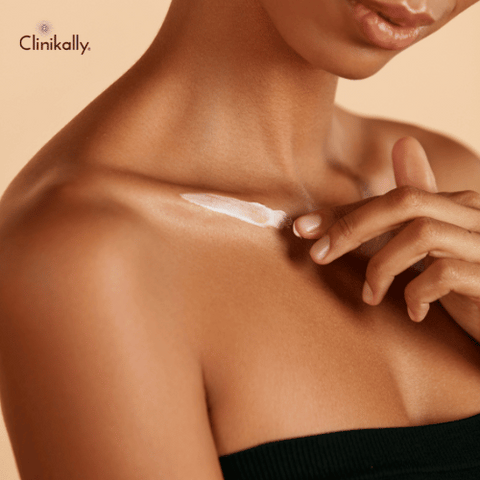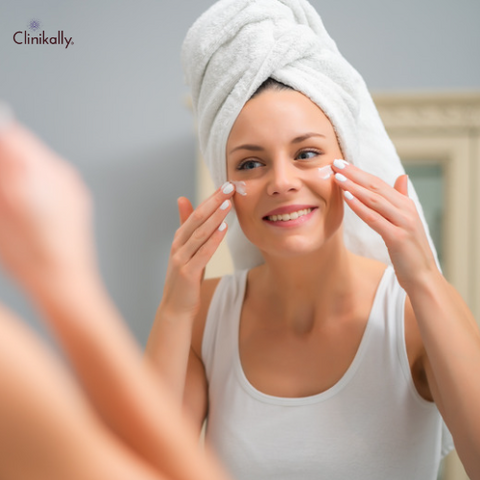Stearic acid is a versatile fatty acid that is commonly used in skincare formulations. It is a white, waxy, solid substance derived from animal and vegetable sources that are insoluble in water. Stearic acid is frequently used in skin care as an emulsifier, which means it helps to bind together ingredients that would not normally mix, such as oil and water. It can also thicken and stabilise formulations, making them easier to apply and increasing shelf life.
Stearic acid can also be used as a cleansing agent, assisting in the removal of dirt and oil from the skin. It can help reduce the appearance of acne and other skin blemishes and control excessive sebum production. Furthermore, stearic acid has moisturising properties, which help to keep the skin hydrated and prevent dryness and flakiness. It is also thought to have a soothing effect on the skin, which can aid in the relief of redness and irritation.
Decoding Stearic Acid and Its Use in Skincare

A saturated fatty acid called stearic acid is frequently used in skincare formulations and other cosmetic products. It is a solid, white, waxy substance with a melting point of about 70°C that is derived from natural sources like vegetable or animal fats. Stearic acid functions as a surfactant and emulsifier in skincare products. Surfactants help to reduce surface tension, allowing water and oil to mix more easily. Emulsifiers help mix water and oil-based ingredients in a formulation. Because of its emulsifying and surfactant properties, stearic acid is an excellent ingredient for lotions, creams, and cleansers. It aids in the stabilisation of these products, giving them a smooth and creamy texture and preventing separation over time. Stearic acid can help make skincare formulations more viscous because it also has thickening properties. This can make a product more spreadable and effective overall, making it simpler to use and more potent. Stearic acid has skin-conditioning properties in addition to its emulsifying and thickening properties. It can soften and smooth the skin, improving its texture and appearance. It also has hydrating properties, which aid in the prevention of dryness and flakiness.
What is Stearic Acid?
Stearic acid is widely used in various industries, including food, pharmaceuticals, and cosmetics. It is often used as an emulsifier and stabiliser in these industries, helping to bind together ingredients that would otherwise separate, such as oil and water. In the cosmetics sector, stearic acid is frequently used as a component in skincare products. It has emollient properties, meaning it can help soften and soothe the skin. It is also used as a thickener and texturizing agent, helping to give skincare products a smooth and creamy consistency. In general, stearic acid is safe to use in skin care products in the right concentrations. However, some users of stearic acid-containing products might experience skin irritability or other negative effects.
Natural and Synthetic Sources of Stearic Acid
Stearic acid is found naturally in animal fats such as beef tallow, pork lard, and butter, as well as plant oils such as cocoa butter and shea butter. These natural sources of stearic acid are frequently preferred by consumers who favor natural or organic ingredients. In contrast, synthetic stearic acid is typically derived from petroleum or other chemical sources. This stearic acid is frequently employed in commercial settings, including the production of lubricants, plastics, and rubber. In the cosmetics sector, stearic acid can be produced synthetically or naturally. However, synthetic stearic acid can also be used in cosmetic formulations to achieve specific properties or functions. Natural sources of stearic acid are frequently preferred by consumers who prefer natural products.
The Functions of Stearic Acid in Skincare Products
As a result of its many uses, stearic acid is a common ingredient in skincare products. Here are some of the key functions of stearic acid in skincare products:
-
Emulsifier: Stearic acid is a powerful emulsifier, which means it aids in blending ingredients with both water- and oil-based compositions. This is important in creating stable and consistent formulations for skincare products.
-
Thickening agent: The thickening properties of stearic acid help to give skincare products a smooth and creamy consistency. This can enhance a product's texture and spreadability, making it simpler to use.
-
Surfactant: Stearic acid is also a surfactant that aids in the reduction of surface tension in a product. This makes it easier for the product to mix with water and oil-based ingredients.
-
Skin conditioning: The moisturising qualities of stearic acid help to smooth and soften the skin. It can also help to create a protective barrier on the skin, reducing moisture loss and preventing dryness and flakiness.
-
Cleaning agent: Stearic acid has cleansing properties that make it efficient at removing dirt, oil, and impurities from the skin. It is frequently utilised in facial cleansers to assist in maintaining clear, clean skin.
The Skin Benefits and Applications of Stearic Acid

Stearic acid is a common component in skincare products because it may have several advantages for the skin. Here are some of the most important skin benefits and applications of stearic acid:
-
Moisturization: Stearic acid is an emollient, which means it can soften and soothe the skin. It forms a protective barrier on the skin, aiding in moisture retention and keeping the skin hydrated and moisturised.
-
Skin conditioning: Stearic acid smoothes and softens the skin, which can help to improve its texture and appearance. It can also help to reduce the appearance of fine lines and wrinkles by improving the skin's elasticity.
-
Cleaning: Stearic acid is a cleansing substance that can assist in clearing the skin of impurities, oil, and dirt. Its effectiveness as a skin cleanser makes it a good ingredient for facial cleansers and other skincare products.
-
Emulsification: Stearic acid is frequently utilised in skincare products as an emulsifier to assist in combining ingredients that are water- and oil-based. This makes formulations more dependable, simple to use, and capable of bringing about the desired effects.
-
Thickening: Stearic acid can aid in the thickening of skin care products, giving them a smooth and creamy texture. This can improve the texture of the paint and make it easier to apply.
Emulsification and Stabilization
In the world of skincare and cosmetic formulations, emulsification and stabilisation are two closely related concepts. The process of combining two or more immiscible (unmixable) liquids, such as oil and water, to form a stable mixture is known as emulsification. On the other hand, stabilisation describes a formulation's capacity to hold onto its physical characteristics over time without separating or degrading. Stearic acid is important in the emulsification and stabilisation of skincare products. Stearic acid, as an emulsifier, can aid in the combination of oil-based and water-based ingredients in a formulation, resulting in a stable mixture that does not separate over time. This is necessary to produce skincare products that are simple to use, supple, reliable, and efficient. Stearic acid also aids in the stabilisation of skincare products by assisting in the preservation of their physical properties over time. This includes preventing the formulation from separating or breaking down, as well as assisting in the retention of the product's intended texture, colour, and fragrance.
Supporting Skin Barrier Function and Hydration
Stearic acid can help with skin barrier function and hydration in a variety of ways.
-
Stearic acid is a natural component of the skin's barrier layer, and its inclusion in skin care products can help to strengthen this layer. The barrier layer of the skin protects the skin from external factors such as pollutants, irritants, and allergens, as well as prevents moisture loss from the skin. Stearic acid can help to maintain skin health by reinforcing the barrier layer and preventing dryness and irritation.
-
Stearic acid is an emollient, which means it can soften and soothe the skin. It forms a protective barrier on the skin, aiding in moisture retention and keeping the skin hydrated and moisturised. This is especially beneficial for people who have dry or sensitive skin because it can help to relieve dryness and reduce the risk of irritation.
-
Stearic acid can aid in the absorption and effectiveness of other skincare ingredients. Its emulsifying properties can help to improve active ingredient delivery to the skin, allowing them to penetrate deeper and provide more benefits.
Enhancing Texture and Consistency
Stearic acid is commonly used to improve the texture and consistency of skincare formulations. It has thickening and stabilising properties that can aid in the creation of smooth, creamy, consistent, and easy-to-apply products. A formulation's viscosity can be raised by adding stearic acid as a thickener, making it visibly thicker and heavier. This can improve the product's texture and feel, making it more enjoyable to use. Stearic acid can also aid in the creation of a more uniform texture, lowering the likelihood of separation or clumping. Stearic acid, in addition to its thickening properties, can also act as a stabiliser. It can aid in keeping the various ingredients in a formulation well-mixed and prevent separation over time. This is required to create goods that function and feel the same throughout their shelf life.
Evaluating Stearic Acid's Safety and Efficacy

Stearic acid is generally regarded as safe for use in cosmetics. It is a naturally occurring fatty acid that can be found in a wide range of plant and animal products. The cosmetics industry makes extensive use of it. Stearic acid was examined by the Cosmetic Ingredient Review Expert Panel, which found that up to 18% of concentrations were safe for use in cosmetic products. However, stearic acid, like all ingredients, can cause skin irritation or allergic reactions in some people, especially when used in high concentrations. Before using a new stearic acid-containing product, you must conduct a patch test to make sure you won't experience any side effects. Stearic acid has been shown to have several skin benefits in terms of efficacy. It can help with the texture and consistency of skin care products, the support of skin barrier function and hydration, and the absorption of other skincare ingredients. Because of these properties, it is a valuable ingredient in a wide range of skincare formulations.
Stearic Acid Safety Profile
Stearic acid is widely used in cosmetic and personal care products due to its generally favourable safety profile. When used in appropriate concentrations, it is considered a low to moderate-hazard ingredient with a low risk of causing skin irritation or sensitization. The Cosmetic Ingredient Review (CIR) Expert Panel determined that stearic acid is safe for use in cosmetic products at concentrations up to 18%. The Scientific Committee on Consumer Safety (SCCS) of the European Union has also examined stearic acid and determined that it is safe to use in cosmetic products at concentrations up to 2%.
It is important to note, however, that stearic acid can cause skin irritation or allergic reactions in some people, especially if used in high concentrations or if the skin is already compromised or sensitised. Before using a new stearic acid-containing product, you must conduct a patch test to make sure you won't experience any side effects. Stearic acid is also considered a safe ingredient to use during pregnancy and breastfeeding because it is not absorbed in significant amounts through the skin. However, as with all ingredients used in skincare, it is always advisable to seek medical advice before using any new product while pregnant or nursing.
Skincare Products with Stearic Acid
Stearic acid is a common ingredient in many skincare products, including:
-
The natural moisture barrier of the skin is supported by stearic acid, which is frequently used in moisturisers to aid in locking in moisture. It can also assist in producing a texture that is easy to apply and smooth and creamy.
-
Stearic acid can be added to cleansers to enhance the texture and aid in the production of a lather. It can also help to remove excess oil and impurities from the skin.
-
Sunscreens that contain stearic acid have better textures and adhere better to the skin. The ingredients in sunscreen may benefit from stabilisation, which increases their potency.
-
Stearic acid is frequently used in anti-aging cosmetics to support the skin's natural collagen production process and lessen the visibility of fine lines and wrinkles.
-
A rich, creamy lather that helps to lubricate the skin and lessen irritation can be produced by adding stearic acid to shaving creams.
-
Stearic acid is often used in body lotions and creams to help create a smooth, creamy texture that is easy to apply and absorbs quickly into the skin.
Sustainability and Ethical Considerations
When thinking about stearic acid's sustainability and ethical implications, there are a few things to keep in mind. To begin with, stearic acid can be obtained from both plant and animal sources. Stearic acid derived from plants is frequently derived from palm oil, which has been linked to deforestation, habitat loss, and environmental degradation. However, sustainable palm oil and stearic acid derived from other plant-based sources, such as coconut oil, can be a more environmentally friendly option. Second, stearic acid can be obtained from animal products such as beef fat or tallow. However, some clients might have moral reservations about the use of ingredients derived from animals in skincare products, particularly those who follow the vegan lifestyle or would prefer to stay away from animal products for other reasons. Stearic acid-containing skin care products must consider their overall environmental impact as well as the effects of their packaging and manufacturing processes. Look for brands that prioritise sustainable and ethical practices, such as eco-friendly packaging and reducing waste and emissions throughout the manufacturing and supply chain.
Navigating the World of Skincare Ingredients: The Role of Stearic Acid

Stearic acid is a versatile ingredient in skincare products that is used to improve texture and consistency, as well as the function of the skin barrier and hydration. It is derived from both natural and synthetic sources, and its safety profile is generally good. Stearic acid may be used in skincare products, but it is also crucial to take sustainability and ethical issues into account, such as the ingredient's impact on the environment and the brand's production and packaging practices. As with any skincare ingredient, it's important to be aware of the potential advantages and disadvantages of stearic acid before choosing products that contain it. You should also carefully consider your unique skincare requirements and preferences. You can confidently navigate the landscape of skincare ingredients and create a skincare regimen that supports your particular needs and values by staying informed and aware of your options.
















